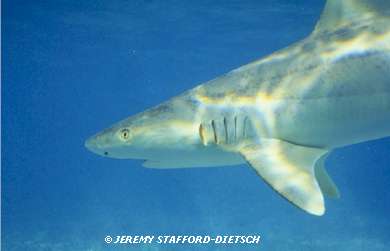The Importance of Being
Cartilaginous
Why is a shark's body composed of cartilage and what is the evolutionary advantage of this?
Heather
Castlegar, B.C.
A shark's body is — of course — composed of many different types of tissue, of which cartilage is but one. If I may be permitted to presume, I think that what you meant to ask is something along the lines of: for sharks, what is the evolutionary advantage of having a cartilaginous skeleton?
If I have second-guessed your meaning correctly — and please forgive me if I have misunderstood — that's a splendid question, Heather!
Unlike most vertebrates, sharks do not rely on their internal skeleton to provide them with firm sites for muscle attachment. Instead, underneath their sandpapery outer covering (studded with countless thousands of tiny, tooth-like scales called 'dermal denticles' ), sharks have a thick skin composed of a complexly criss-crossed meshwork of tough-but-springy fibres made of a protein called collagen. This meshwork of collagen fibers forms a kind of 'corset' to which the swimming muscles attach. By having their swimming muscles attached directly to the tough, armor-like skin, the skin is able to act as a kind of external skeleton. From a mechanical perspective, having the muscles attached directly to an external skeleton is a very efficient arrangement, resulting in very little waste of muscular energy — which explains why even the tiniest crab can give such a disproportionately painful nip!
 All sharks, like this Blacknose
Shark (Carcharhinus acronotus), have a an internal
skeleton composed of cartilage, which is tough, flexible, and
light-weight. This gives sharks many of the structural and 'flight'
benefits of model aircraft constructed of balsa wood.
All sharks, like this Blacknose
Shark (Carcharhinus acronotus), have a an internal
skeleton composed of cartilage, which is tough, flexible, and
light-weight. This gives sharks many of the structural and 'flight'
benefits of model aircraft constructed of balsa wood.
Photo © Jeremy Stafford-Deitsch; used with the gracious permission of the photographer, who asks that you support the Shark Trust.
Another benefit of having an internal skeleton made mostly of cartilage is weight reduction. Cartilage is tough but supple and only about half as dense as bone. Because of its relatively low density, a shark' body mass is significantly reduced and therefore requires substantially less energy to propel through the water. Since sharks lack any trace of a swim bladder — an internal organ that many bony fishes use to achieve neutral buoyancy by the controlled secretion and absorption of the gases within it — they are largely dependent upon dynamic lift, much like a glider. The less muscular energy a shark has to commit to avoid sinking, the more is available for forward propulsion. Thus, by having a light-weight internal skeleton, sharks reduce the amount of energy needed to swim. And by relying on a tough, 'external' skeleton formed by the skin, sharks increase the efficiency of swimming muscle contraction without incurring any loss of bodily support.
